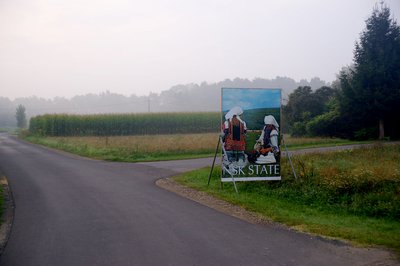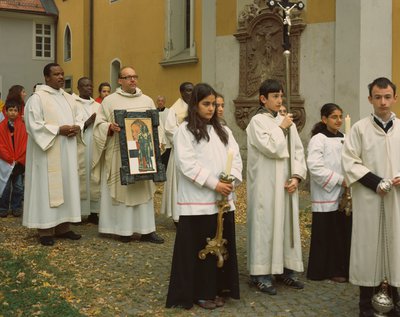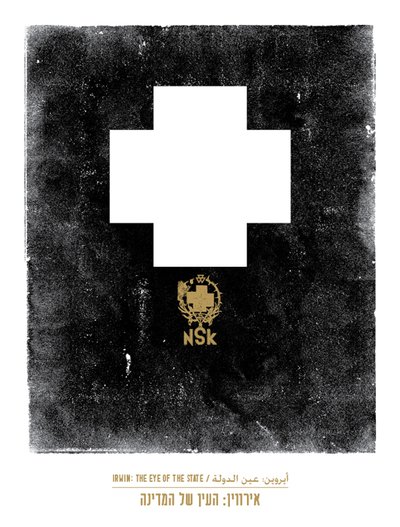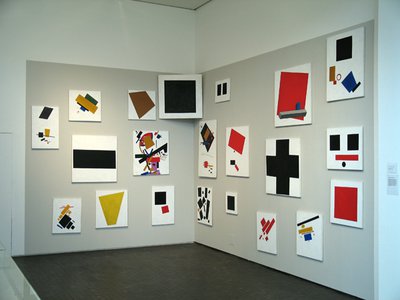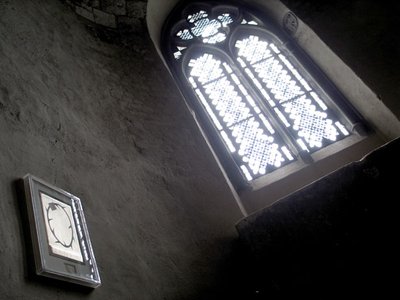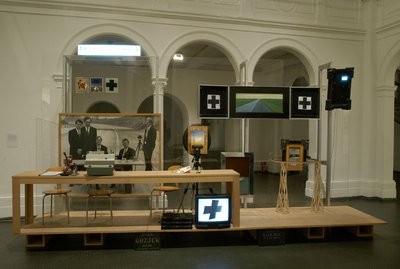On 25.04.2003, IRWIN launched their exhibition "Icons - Malevich between two wars" in Galerie Inge Baecker in Cologne, Germany. The exhibition can be seen as some kind of preview to the already planned and scheduled larger IRWIN-exhibitions to follow, among them the one in Kyoto or in Berlin in September 2003. IRWIN thus take the opportunity to show selected pieces of their new works to an interested public previous to these forthcoming larger events. Cologne's Galerie Inge Baecker is certainly not quite a new terrain for IRWIN, previous exhibitions of the group already took place at this location, as Mrs. Baecker is truly connected with IRWIN an thus she already took the opportunity in the past to support IRWINs work with exhibitions of the group in her gallery.
The opening of the exhibition featured two rooms with more or less brandnew IRWIN-works and the presence of some members of IRWIN.
With ICONS, IRWIN obviously take a step towards a simplification tendency in their use of asthetical structures and symbolics: In the past, they had made use of lots of different and sometimes contradictious symbols from various political, religious and artistic schemes, like at the same time slovene national, communist/socialist, christian, fascistic and suprematistic/futuristic symbolism in for example the early works of the "Was ist Kunst"-series. The pictures then featured many different persons, signs etc. of the above-mentioned general topics, like for example for the Christian/orthodox part images of jesus, mary, angels, priests, etc. as various representatives/icons of mainly the same idea.
In this sense, without losing the original concept of mixing up most different and partly opposing symbolisms, with ICONS, IRWIN now restrict themselves to four basic symbols from the above-mentioned topics which are the "cup of coffee", the cross, the deer and "the little drummer" as already well known basic inspirations of IRWIN's, LAIBACH's and NOVI KOLLEKTIVIZEM's since the 1980ies.
In detail, these symbols could be seen as representatives of four different parts of life and art:
The "cup of coffee" as a retreat to privacy and individuality by symbolizing something absolutely normal/everyday-like and connected neither to art nor to politics. In connection with the symbol of the "cup of coffee", an IRWIN-member stated that in detail, this is even a typical symbol of Slovene national art of the past, with exactly this meaning, that is why it was picked up again by NSK, starting already in the early 80ies with the well-known poster of the exhibition "Ausstellung LAIBACHKUNST" in Galeria SKUC, with the coffee-drinking woman on it.
The cross, as some kind of universal symbol for on the one hand religious (Christian) and on the other hand political/artist (Malevich-like suprematist asthetics) purposes, has been used by NSK often in the past as a geopolitical symbol for the sake and evil of the Balkan as the new center of Europe between to opposing sides of the world.
The deer might serve various asthetical/artist meanings from simply symbolizing nature and biological life -by the antlers including the natural need of fight for survival and supremacy- up to more detailed possibilities of interpretation like typical German/Austrian kitsch-kunst and alpine folkloristic elements.
Lastly, the "little drummer" concludes this "clash of symbols", being an asthetical connection to LAIBACH's stage-performances and thus -and in general- reflecting on timeless instruments of propaganda in images and sound.
As Roman Uranjek of IRWIN put it, this restriction to four basic elements is meant to strengthen the message of the images, because the repetition of always the same symbols again and again should force the viewer to think about these symbols and their connections and links to each other as well as about the viewers own point towards these symbols. This massive confrontation of the viewer would -in this sense- not be possible by the use of a larger amount of different symbolics, which would make this massive confrontation more difficult because of the confusingly large amount of symbols. For the creating members of IRWIN after his words, the restriction -and thus concentration on and permanent repetition of- these basic symbols is a sign of an artist's extreme passion towards his works.
In spite of the decrease of the symbols used, the general idea behind the mixture of the symbols seems to remain the same. By combining symbols, which contradict each other aesthetically as well as in their visual or hidden meanings, together to one new -and surprisingly functionable- whole, IRWIN encourages the viewer once more to reflect critically on the use and effect of these symbols in all parts of life. Once again, an NSK-group sticks to the rule to be not an answer to anything, but a question given back to the viewer/consumer.
Example works:
Some examples from the now exhibited works for the use of these symbols might be -among others- the image "cup of coffee" in combination with the malevich-cross printed on it and installed in front of a large 3-dimensional and irritating background of a digitised landscape showing the fact that a total retreat to strict individuality and normality is impossible.
Another example is the "littler drummer"-series in different materials and color-styles obviously representing different means of propaganda: in one version ("In blood we trust"), partly painted with blood and in an aggressive manner, the image seems to be referring to the right now very actual topic of political/wartime-propaganda. In another version right next to this one, "The blue boy" comes along with applications of jeans-textiles drawing a connection to the less horrifying but still disturbing idea of commercial/fashion "propaganda" of western (American) culture.
The deer once again serves as a reference to most different ways of art, explained best by one work showing the dear in front of a background consisting of four different-colored squares, representing some French artist's/philosoph's view of strictly separating four kinds of art (concecrated art, mainstream-art, avantgarde and non-art). By placing the dear right in the center of these squares, the senselessness of these borders becomes clear and the viewer is pushed to the question, what art is ought to be anyway ("Was ist kunst?").
Lastly, a good example for the most ambivalent of these symbols, the cross, IRWIN worked out a picture consisting of four different crosses, in the best meaning "crosslinked" to each other. In the center, a classical golden Christian cross. On one rafter of this cross, the well-known black and white malevich-cross is applicated in the (politically most disturbing) form of a textile armlet already known from past LAIBACH-appearances. The background of these first two crosses is formed by another (this time more originally version) of the malevich-cross as a suprematist/avantgarde political reference.
The most disturbing cross to follow is as the background of the whole image, a mirrored red swastika, thus representing nationalsocialistic/fascistic asthetics and by the same time the original meaning of the traditional sun-symbol in pre-christian religions.
Besides this slight change in the general use of different symbols, there has -in my eyes- as well been a slight development in the general aesthetic outline of IRWIN's works. In some way, without having a real and objective reason for that, the images seem to appear in a more "modern" and sophisticated optical manner. Without changing the original concept of large and massive frames (which are a basic principal of IRWIN's works anyway) and the partly strange mixture of various different styles and materials, IRWIN in my opinion managed to move the aesthetics of their 1980ies works to the time of 21st century. The basic appearance concerning frames, materials and outline are kept, but the moves towards a slight increasing of "modern" materials like plastic (especially lego-parts), bright aluminium/metal and white glass makes the images look "modern" (whatever that means...) and timeless by the same time.
During the whole evening of the opening, IRWIN-members Roman Uranjek and Burot Vogelnik where present, and the guests had the great opportunity for a personal talk and discussion on the images and their possible meanings. They were both happy to explain their views on certain symbolics, used materials and their way of working in the collective of IRWIN to everyone asking, which made the evening quite an interesting event for me and everyone else who was interested in more background-information on IRWIN and NSK.
